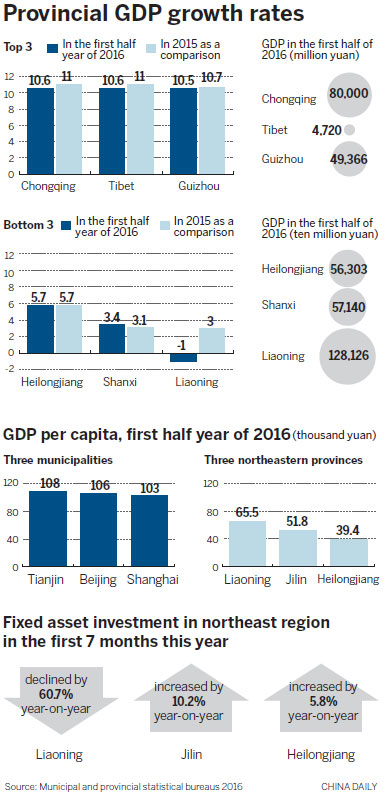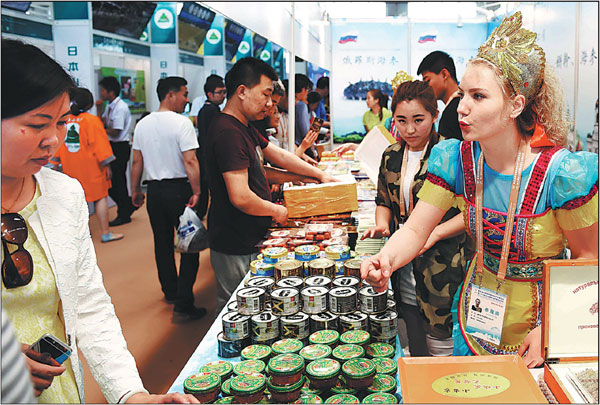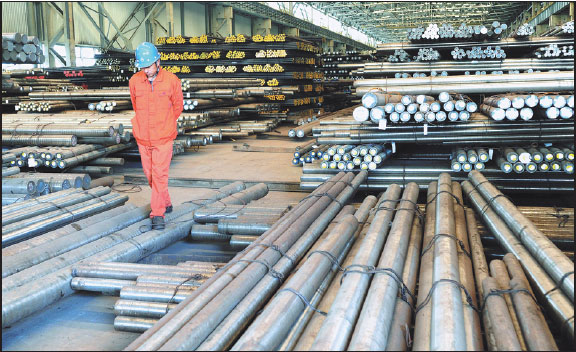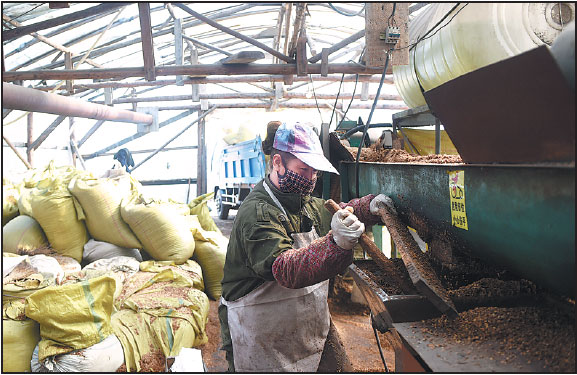Northeastern provinces need core reform
Wide disparity in growth rates shows value of western provinces' diverse industries
China's economic growth is on the path to achieve more balanced and inclusive growth, but some regions that face stronger headwinds need to quicken up the pace of industrial upgrade, according to economists.
A study of regional economic growth shows that inland regions are taking the lead, using policy support to create diverse industrial structures. On the other hand, old industrial bases that are grappling with overcapacity problems are lagging behind.
In the first half of this year, a total of 23 regions outpaced the 6.7 percent national growth rate. Eleven of those are western inland regions.
Chongqing held onto the top spot in the first half of this year with a 10.6 percent growth rate, following 10. 7 percent in the first quarter. Zhang Fumin, deputy head of municipal statistics bureau, said that it is quite difficult to achieve such performance at the time when the nation is facing downward economic headwinds.
"Industrial upgrade and a diverse economic structure has paid benefits for the local economy," said Zhang.
Su Jian, an economics professor with Peking University, said that the central government policy inclination played a rather significant role, referring to tax cut policies that attract companies to settle in underdeveloped regions. He added that, with its well-established infrastructure, the city is likely to continue to take the lead in the future. The One Belt-One Road initiative will "give it a boost", so the city is expected to become a transition spot for business along the belt and road.
Earlier in September, the city was approved by the central government to be one among seven regions to set up new free trade zones, creating more opportunities for trade and investment, according to Bai Ming, a research fellow at the Chinese Academy of International Trade and Economic Cooperation.
At the same time, more developed regions in eastern China have also benefitted from economic upgrading.
In the first half of this year, the value-added of information technologies and information services in Beijing attained 118.5 billion yuan, up by 11.2 percent year-on-year, and in Shanghai that sector stood at 77.3 billion yuan, which is 16.5 percent higher than the same period last year.
However, regions that rely heavily on the old-manufacturing model need to quicken up the pace to upgrade economic structure, economists said. They have had the lowest growth in the nation, despite a mild ticking up in the first half of this year.
Heilongjiang, Shanxi, and Liaoning provinces are the nation's worst performers, with 5.7 percent, 3.4 percent and negative 1 percent growth in the first half, respectively, ticking up a little compared to the 5.1 percent, 3 percent and negative 1.3 percent growth in the first quarter.
"Old industrial bases face more difficulties compared to other regions, but we should not lose hope for them," said He Zhicheng, the former chief economist with the Agricultural Bank of China.
He noted that Jilin, which is located in what has been called the northeast rustbelt, achieved 6.7 percent growth-the first time that the province registered the same growth rate as the national level since 2014.
Echoing his statement, Hu Angang, an economics professor at Tsinghua University, said that the northeast region has comparative advantages in agriculture and manufacturing industries, "but enterprises need to turn to high-end products."
The region has been struggling with cutting overcapacity, but some small enterprises in the sectors with overcapacity started production again in the first half, after being shut down earlier.
Hu said this is not sustainable. He said the local governments' determination to implement structural upgrade matters the most if the region is to achieve growth in sustainable ways.
"The central government has given much policy support," he said.
The National Development and Reform Commission, China's top economic regulator, issued a three-year plan (2016-18) in mid-August to help the northeast region boost growth. The plan includes 137 key tasks that must be accomplished in the 3 years, covering issues such as economic upgrade, social welfare and simplifying administrative procedures, according to Zhao Chenxin, spokesman for the National Development and Reform Commission.
A total of 127 fixed-asset projects valued at 1.6 trillion yuan (240 billion dollars) will be launched during the period to support the region to finish the tasks on time, according to Zhao.
Hu said that investment in infrastructure, public transport and public facilities are necessary to pave the way to growth, but the local governments need to make sure that the money flows to projects that would help tap economic potential in the region.
An official with the commission, who declined to be named, held similar views, and highlighted the role that local governments should play in implementing the plan.
"The nation has released guidelines and provided support to the northeast region for more than 10 years, but merely pouring in money cannot help the region boost growth," he said.
"The key thing is to change the old administrative mechanisms," he said. "The private sector needs to have equal opportunities compared to large-state owned enterprises-growth in the private sector would help bump the region out of the slow-growth trap."
In the first half of the year, investment in the private sector in Liaoning province declined by 58.1 percent, the worst performer in the nation, data from the NDRC show. During the first seven months of this year, fixed-asset investment in the northeast region dropped by 60.7 percent year-on-year, which is 2.6 percentage points lower than the first half.
The performance of Liaoning province is the major factor that dragged down the overall performance of the nation's fixed-asset investment, said a report released by China International Capital Corp in the mid-July.
The NRDC official added that local governments should monitor the pace of how key tasks listed in the plan are implemented. "Resolving deeply imbedded administrative problems would be more helpful for the region - more than the 127 fixed-asset investment projects will be," he added.
wangyanfei@chinadaily.com.cn
|
Visitors seek information about products from booth managers at the 27th China Harbin International Economic and Trade Fair, which ended on Sept 19.Wang Jianwei / Xinhua |
|
A worker walks through stacks of steel rods in a State-owned steel plant in Northeast China's Liaoning province. The problem of overcapacity is especially serious in the three northeastern provinces.Liu Debing / For China Daily |
|
A worker prepares mushroom products in a workshop in Baihe, Jilin province, on March 22, 2015.Lin Hong / Xinhua |

(China Daily 10/03/2016 page6)

















